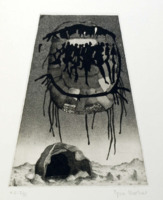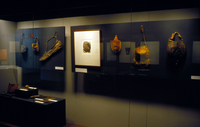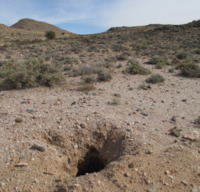Items
Site
The Medicine Chest
keywords is exactly
Iziko South African Museum
-

Etching from 'Sound from the Thinking Strings'
"Skotnes’s own visual interpretation of the history and cosmology of the |xam formed the last component of this interdisciplinary endeavour and constituted a visual component that drew together the various strands of disciplinary interpretations and presented a perspective on the |xam life she felt ‘was missing from the other interpretations’ (Skotnes 1991: 30). In these images she drew freely on San mythology, accounts of |xam life recorded by Lucy Lloyd, historical and archaeological research and images from rock paintings in a landscape setting. She writes in her preface that these etchings were direct attempts at ‘inverting the museum dioramas’ in the ethnographic halls close to the exhibition and which, through their display of the San’s body casts, rendered them closer to specimens of biology than as members of a highly developed culture (Skotnes 1991: 52). By creating images that combined shamanistic rituals, entoptic spirals, plants, hunting bags, bows and arrows, snakes, eland-shaped rainclouds, colonists, musical instruments, shelters and therianthropic shapes, Skotnes eclipsed the static narratives of the dioramas and the object labels in the exhibition, placing them in a context in which their metaphysical qualities were celebrated more than their physical qualities. These prints stood in striking contrast to the other exhibits, which framed the San as physical types, and they challenged viewers to confront the reality that the San had a rich history and cultural and social life" (Liebenberg 2021: 157). -

Sound from the Thinking Strings (installation detail)
"Skotnes had a longstanding relationship with the museum, which started when she was still a student at the Michaelis School of Fine Art. Davison remembers that Skotnes would visit the taxidermy section of the South African museum to draw bones. As an anthropologist, Davison admits to finding Skotnes’s way of looking at things stimulating – an individual way of looking at objects that made her look at them differently, even though she was already very familiar with these materials. Davison recalls a visit to the ethnographic stores during which she showed Skotnes the San skin bags, carefully conserved in their drawers and laid out on acid-free paper. Skotnes admired not only their aesthetic qualities but related the stories she had been studying in the Bleek and Lloyd archive to them – stories that shifted their status from anthropological museum objects to powerful animate objects in San spiritual and social life (P. Davison, personal communication, 28 January 2021). Skotnes remembers that she asked staff whether they knew what was inside the bags and was shocked when nobody could remember looking in them. She was allowed to look inside one and found a claw, which they thought must be a leopard’s (P. Skotnes, personal communication, 9 May 2021)" (Liebenberg 2021: 2015). -

Unconquerable Spirit: George Stow and the landscapes of the San
In 2008, the exhibition 'Unconquerable Spirit: George Stow and the landscapes of the San' opened at the Iziko Museum of South Africa. Curated by Pippa Skotnes, the exhibition featured the work of a relatively unknown figure in 19th century South African history. George William Stow was a British born, South African geologist, ethnologist, poet, historian, artist, cartographer, and writer who was responsible for a creating large collection of watercolours and drawings that documented the rock art he found in the caves and shelters of South Africa. The exhibition brought together a vast range of materials representing Stow’s life and the period in which it was produced – from his drawings and paintings; his letters, documents, and poems; to his maps, and field diaries. The display shows one map in particular which is kept as part of the National Library of South Africa collections, and was drawn by Stow during the period he was conducting geological surveys of the country surrounding the diamond fields of Kimberley, down to the junction of the Orange and Vaal rivers and beyond. It shows amongst other things, the diamondiferous deposits of the Vaal river during the late 19th century and, as part of this section of the exhibition which focused on Stow the geologist, Skotnes displayed it alongside relevant disciplinary materials she sourced from the Department of Geological Sciences, University of Cape Town. -

Geological Map of the Vaal River (from 'Stow: a geological fieldguide of UCT')
"Stow’s discovery of coal deposits in 1878, found in the beds of the Vaal River, was of interest to the diamond magnate, Sammy Marks. Marks realised the importance of Stow’s discovery and the opportunity for using coal at the Kimberley diamond fields for energy generation (Leigh, 1968:112). He believed he could transport the coal from Vereeniging to Kimberley by floating it down-river by a series of weirs to his diamond claims. This turned out to be impractical and he had to resort to using ox-wagons as a method of transport instead (Leigh 1968:17). Marks & Lewis who at that time owned a quarter of all the Kimberley diamond claims, sold most of their Kimberley claims to concentrate on the coal finds through their newly formed mining company, the Zuid-Afrikaansche en Oranje Vrystaatsche Mineralen en Mijnbouvereeniging (later to become the Vereeniging Estates Limited). In 1892, the small village of Vereeniging was formally established" (Liebenberg 2021). -

Geological Map of the Vaal River
Geological Map of the Vaal River, from Fourteen Streams to the Kareyn Poort shewing the Various Formations, and the Positions of the Diamantiferous Deposits. Sheet No 11'. -

Breath Sculptures
In the exhibition, 'Chest: a botanical ecology', "this cabinet extended the ideas of fragility and fallibility represented by the broken glass laboratory bottle, displaying four ‘breath sculptures’ made by the five individual breaths of children who suffer from asthma: Thaakira Salie (aged 8), Ziyaad Small (aged 10), Blake Leppan (aged 9) and Jessie Allot (aged 11). Working in collaboration with the Allergy Foundation of South Africa and Andre de Jager, UCT’s resident glass blower in the Department of Chemistry, I facilitated a workshop in which the children were taught the practice of blowing glass and then produced their own sculptures by breathing into molten glass. The breath sculptures made by these children were far removed from the functional bespoke glassware usually produced in the workshop for chemical experiments or for those conducted for physics and chemical engineering (A. de Jager, personal communication, 20 August 2018)" (Liebenberg 2021: 263). -

Hamish Email
An email between artist-curator and Dr Hamish Robertson. Robertson was invited to Hiddingh campus in his capacity as entomologist (and then Director Natural History Collections at Iziko Museums of South Africa) to assess the environment in terms of biodiversity prior to the staging of the 'Where the Wild Things Are' exhibition. -

Holes
The landscape of the Karoo and the Northern Cape – the land of the |xam – is rich with holes in the ground. Below the surface of the earth burrowing animals navigate their way through the roots of grasses and shrubs, small trees and creepers. Holes are made and inhabited by scorpions and spiders, mice and shrews, suricats and mongooses. One of the most energetic of burrowers is the anteater whose holes, in places, transform the landscape. Anteaters are such active diggers and their holes so numerous that abandoned burrows are quickly occupied by bat-eared foxes, hyenas, hares, civets, bats, jackals, owls and porcupines (Skotnes 2010: 26)


